Green Hydrogen Fuel Cell Vehicles over Battery Vehicles – What’s Best?
Transportation has contributed to the U.S.’s 27% of 2020 greenhouse gas emissions and holds the largest share of greenhouse gas emissions. As a result, two technologies have emerged to meet the decarbonization need of the industry- Li-ion battery electric vehicles and green hydrogen fuel cell vehicles.
While one technology is more commercialized, another is still in its infancy. But what does the research state? Is Green Hydrogen better than Li-ion Battery EVs, or is it subjective? All these and many more questions are answered in this article. Let us get started.
Position of various countries w.r.t renewable energy
The Paris agreement in 2015 was signed by 196 countries to limit global warming to below 2 degrees Celsius, compared to pre-industrial levels. The agreement provides a framework for financial, technical, and capacity-building support to those countries that need it.
Since then, many countries are investing heavily in renewable energy.
Besides making the environment pollution-free, renewable energy holds the potential for greater advantages that can make a nation powerful in geopolitical wars. Hence countries like China and the US are aggressively trying to increase their renewable energy capacity each year.
Additionally, China has already announced its long-term hydrogen plan, which will produce 100,000 to 200,000 tons of renewable-based hydrogen annually and have a fleet of 50,000 hydrogen-fueled vehicles by 2025.
China is already the highest producer of Hydrogen, and becoming the highest producer of renewable hydrogen would also help increase the market for Fuel Cell Electric vehicles, for which China is positioned third.
India’s take on Green Hydrogen and present investments in the technology
India also holds a spot amongst the top countries that are making fast progress in the renewable energy sector. India has seen the fastest growth (5.5X) in increasing solar capacity than any other country since 2016. After working in the solar energy sector, India is now ready to become the hub for producing Green Hydrogen to reduce carbon emissions in multiple industries, including transportation, chemical, and steel.
Green Hydrogen, which many have considered “the fuel of the future,” has emerged in the EV sector.
After the Indian Government announced the use of Green Hydrogen, Reliance, one of the Indian conglomerates, also announced investments in the technology. Mr. Mukesh Ambani (Reliance) is boldly investing $75 billion in both blue and green hydrogen. Adani Group also announced an investment of $70 billion into renewable energy and aims to produce the cheapest hydrogen on earth.
Even TATA is already looking to build buses with Hydrogen fuel cell technology in this race.
Looking at Green Hydogren’s traction, the following questions have emerged:
Why Green Hydrogen, and how is it better than li-ion battery EVs?
The performance and efficiency of the technology also rely on how it gets produced. We shall look at the production steps of Green Hydrogen before laying a comparison of it with Li-ion Battery EVs.
How is Green Hydrogen Produced?
To put it straight, hydrogen production happens in many ways. And based on the method and the source of its production, hydrogen is categorized into four major categories.
The first type is gray hydrogen which is produced by breaking down methane and coal through steam methane reforming.
Then we have blue hydrogen, exactly like gray hydrogen, but in this case, 95% of the carbon byproduct is captured, stored, and reused.
Then we have the third type, turquoise hydrogen, produced by pyrolysis. Lastly, we have green hydrogen produced using renewable energy, and the process to get this hydrogen is called electrolysis.
As you can see clearly, green hydrogen, as the name suggests, is the cleanest form of hydrogen, wherein there is no carbon byproduct at all.
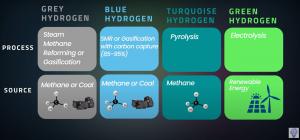
There is also Red or Purple Hydrogen which is also referred to as Nuclear-produced Hydrogen as they are produced using very high temperatures from Nuclear Reactors.
Now the misconception people have over here is that when we say hydrogen fuel, most people think hydrogen is a source. Still, in reality, hydrogen is an energy carrier and not an energy source.
That means if you look at the production of green hydrogen, first, there will be a solar power plant that will produce electricity. Then this electricity is used to conduct electrolysis. As this current passes through water which is H2O, H2O splits into hydrogen and oxygen, and then this hydrogen is stored and then used to dissipate energy.
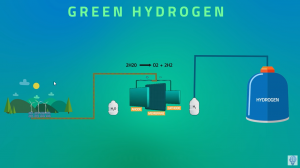
Now, this may raise the query that since electrolysis has been there for decades, why are we talking about green hydrogen electrolysis now and not 15 years back?
That’s because although electrolysis was there, the cost of production of energy through renewable energy was tremendously high.
If you look at the graph displayed below, you will know how much the renewable energy sector has actually changed in the past 10 years. It showcases how the cost of producing electricity from various sources.
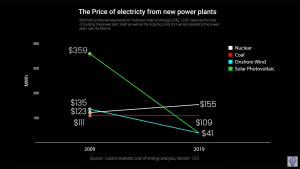
You will see that from 2009 to 2019, the cost of producing electricity from coal decreased by just 2 percent, from 111 dollars to 109 dollars per megawatt-hour. The cost of nuclear has increased by 26 percent from 123 dollars to 155, whereas the cost of onshore wind has dropped by 70, going from 135 to just 41, and the cost of solar has decreased by 89, going from 359 dollars to just 40 dollars per megawatt-hour.
Hence, for the first time in human history, renewable energy source looks way cheaper than fossil fuels. And in the next 10 years, this cost is expected to drop further from 40 dollars in solar to maybe even less than five dollars.
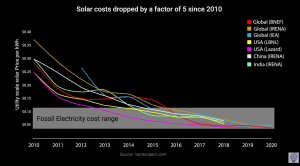
This is why electrolysis suddenly looks like a feasible process to carry out renewable energy production. Discussing all that goes behind Green Hydrogen Production, we must clearly understand why we want to look for an alternative to Li-ion Batteries.
Factors that make Green Hydrogen EVs better than Li-ion battery EVs
While creating a comparison between Green Hydrogen EVs and Li-ion Battery EVs, let’s consider the first factor -Range and volume occupancy. An EV with an advanced lithium-ion battery could achieve a 400-to-500-kilometer range, but these batteries would take up 400 to 600 liters of space, which is enormous. In comparison, the fuel cell plus hydrogen storage tank would take up less than 50 percent of the space.

And in the next five years, considering the advancement in the hydrogen economy, hydrogen tanks, and storage, it would occupy only 100 liters and can give you a kilometer range of 480 to 500 kilometers which means four times less occupancy of space for the same range as lithium-ion.
Secondly, hydrogen fuel cells have an energy-to-weight ratio 10 times greater than lithium-ion batteries. This means if you want to add more range to a vehicle, it is very easy to add to hydrogen cells, but lithium-ion batteries are so heavy that if you want to add range, you will need to increase the size of the battery, which will increase the weight of the vehicle.
So, after a certain point, li-ion batteries will become counterproductive.
Then we have the third factor, which is charging time.
If you look at Tesla Model S, it can give you a 400-kilometer range with 30 mins of charging, and if it is a regular AC charger, it will take up to 4 hours.
But when it comes to hydrogen fuel, even a semi-truck that has a payload of 34 tons and a 400-kilometer range gets recharged in just eight minutes.
The efficiency of Green Hydrogen Technology vs the mode of transportation
After looking at the above three factors, it has been seen that when it comes to passenger vehicles, it might make little difference. Still, these advantages are a massive game-changer when it comes to commercial vehicles.
On studying the graph below on the modes of transportation wherein you plot weight versus mileage – EVs are suitable for up to a weight of 10 tons and a range of 160 kilometers per day.
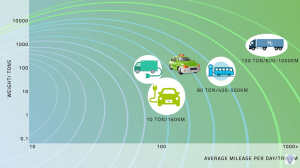
But as soon as you look at heavy utility vehicles like fleets and taxis, it becomes very difficult to use EVs both due to limitations of range and charging time.
A taxi driver cannot stop and charge his vehicle for 4 hours or drive only 150 kilometers a day, right? In contrast, when it comes to hydrogen cells, they are so productive that their applications extend all the way to buses with a range of 400 200 kilometers a day and a weight of 50 to 80 tons to trucks with 100 to 130 tons of weight and 800 to 1000 kilometer range to even trains up to one thousand tons and one thousand kilometer range and beyond.
Further, we have the shipping and aviation industry, which will need synthetic hydrogen-based fuels that are far away from reality.
This is why hydrogen fuel cells are super important because they cater to heavy-duty loads that Li-ion battery EVs cannot deliver for commercial or passenger transportation. But, the growth of Electric Vehicles also demands EV battery recycling, which is the need of the hour to curb the pollution due to these batteries.
Conclusion
Undoubtedly, hydrogen Fuel Cells can revolutionize the world’s transportation industry and save hundreds of millions of carbon emissions every year. We don’t deny the perks attached to Green hydrogen EVs. Lithium-ion battery technology remains the most commercially advanced and practical solution for powering passenger and lightweight electric vehicles. Innovation is focused on applying hydrogen fuel cells for larger-scale, long-distance transport.
All in all, research and debate regarding Green Hydrogen EVs are still ongoing, which can leave you in a dilemma about which technology to invest your time and money into.
Click the button below for a free initial chat with our experts on striking a balance and making the most of these two emerging technologies in the EV domain.

Authored by: Vipin Singh, Marketing team




